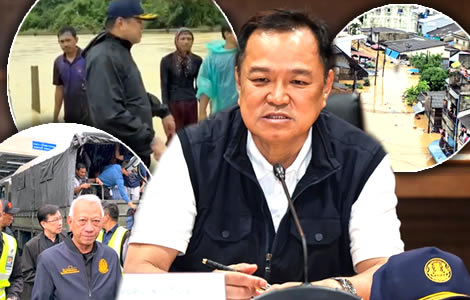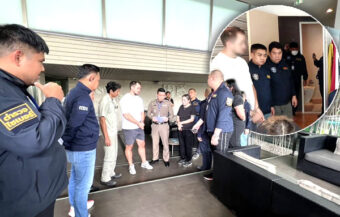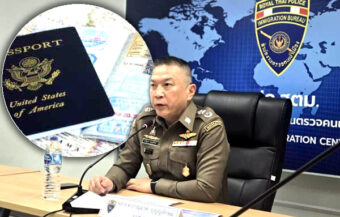33 dead and rising as southern Thailand floods engulf nine provinces, tens of thousands stranded, homes submerged with rescue efforts stretched. PM Anutin remains in Hat Yai, facing mounting public anger and criticism over the government’s response.
Prime Minister Anutin Charnvirakul was in Hat Yai, Songkhla, on Wednesday, fighting severe southern floods that now threaten the core of his minority government’s legacy. At least 33 people are dead and tens of thousands remain stranded. Local anger is rising as devastation spreads and the government’s muddled response falters. Floodwaters have also begun surging in Narathiwat province, spilling into new areas as more bad weather looms. Officials warn the death toll will climb once rescuers reach cut-off communities.

Prime Minister Anutin Charnvirakul remained in Songkhla on Wednesday as the southern flood disaster deepened. The crisis has already taken 33 lives. Sources suggest that the number will rise as rescuers reach more isolated homes. Water continues to block access to several districts. Many people have been trapped since Sunday.
Meanwhile, the prime minister vowed not to leave Hat Yai until the situation improves. He assumed direct command of rescue operations. He said he would not return to Bangkok unless absolutely necessary.
He then cancelled all duties scheduled for the rest of the week. These included the Air Tactical Operations Evaluation opening ceremony and a media event in Phuket.
Prime Minister remains in Hat Yai and cancels all duties to lead flood response amid rising southern disaster
The flooding has expanded across nine southern provinces. Torrential rain continues to feed the disaster. Authorities reported rising water in Nakhon Si Thammarat, Songkhla, Pattani, Yala, Narathiwat, Trang, Phatthalung, Satun and Surat Thani.
However, water in Surat Thani began to fall on Wednesday. Even so, hundreds of thousands of homes remain inundated. More than 2.78 million people have now been affected.
Additionally, health officials reported 14 hospital deaths due to illness in Hat Yai. They denied social media claims of additional deaths. Patients were transferred to Songklanagarind Hospital and other facilities. Oxygen supplies were described as adequate. Distribution was being accelerated.
The prime minister travelled through Hat Yai on Wednesday morning. He arrived with senior ministers, party figures, and Interior Ministry officials. The PM toured Khuan Lang Subdistrict. He also met residents at a bridge over an irrigation canal in Ban Bang Faep Phatthana. Villagers reported that two Department of Disaster Prevention and Mitigation (DDPM) vehicles had ignored their calls for help the day before. The vehicles stopped only when the prime minister arrived.
Flooding spreads across nine provinces as health authorities confirm Hat Yai hospital deaths
Later, he visited Wing 56 in Khlong La Subdistrict. He chaired an online meeting on the crisis. He then moved to Senanarong Camp for another briefing. Transport Minister Phiphat Ratchakitprakarn and Fourth Army Region Commander Lt. Gen. Narathip Poynok attended. All relevant agencies reported damage, casualties and disruptions.
Transport networks across the South remain under pressure. The Marine Department deployed royal barges to reach flooded communities. The Department of Highways and the Department of Rural Roads installed sandbags, filled erosion points and deployed machinery.
Bailey bridges were constructed where routes had collapsed. The Department of Land Transport monitored bus stations and enforced safety measures. The State Railway of Thailand inspected and repaired damaged tracks.
Airport agencies drained water from runways. Airports of Thailand opened donation points and sent aid. Aeronautical Radio of Thailand maintained air traffic systems and supported affected employees. All units were instructed to work around the clock.
Southern transport and emergency agencies mobilised around the clock to maintain rescue operations
Despite these efforts, conditions in Hat Yai deteriorated on Tuesday night. A volunteer on a jet ski reported being shot at while transporting food. He heard three shots behind him. Other volunteers said they faced shouting and thrown bottles.
Residents feared the waves from the jet skis would damage flooded homes. Volunteers said they needed speed to avoid capsizing and to keep debris from tangling their engines.
The tension in Hat Yai rose again hours later. A rescue worker found a woman clinging to a floating refrigerator. Her drowned mother’s body was inside. The incident occurred in Ban Pru, Hat Yai District. The daughter said rising water overwhelmed the home during the night. She placed her mother in the refrigerator so the body would not drift away.
When rescuers reached them, the daughter collapsed on dry ground. The video of the rescue spread online and drew pleas for help from other trapped residents.
Rising tensions in Hat Yai as rescuers face hostility and tragic deaths highlight severity of floods
Across Songkhla, frustration grew as water rose through the night. Thousands of emergency calls arrived within hours. Rescue teams told residents to call only during daylight due to overwhelmed lines. Authorities transferred the Songkhla District Chief on Wednesday. They said the change would help expand the rescue capacity.
Meanwhile, a miscommunication surfaced between the Prime Minister and Deputy Prime Minister Thamanat Prompow. Earlier this week, the deputy prime minister missed an online crisis meeting after travelling to the northern region.
He is the designated commander of the Natural Disaster Water Management Centre. His absence raised questions about command gaps. These gaps affected coordination across agencies. Response delays and conflicting instructions were reported in several districts.
Furthermore, the flooding spread through a wide list of districts. In Nakhon Si Thammarat, more than twenty districts remained submerged. At the same time, in Songkhla, water covered Rattaphum, Muang, Chana, Hat Yai, Na Mom, Bang Klam, Sadao and more. In Pattani, 12 districts were underwater. Meanwhile, in Yala, at least eight districts faced rising water. Narathiwat reported flooding in 12 districts, including Tak Bai and Sungai Kolok.
Miscommunication and command gaps compound flooding across Songkhla and southern provinces
The Department of Health said more than 20,000 displaced people were staying at 273 shelters. Water levels were rising in the most affected zones. Only Surat Thani reported improvement. The Meteorological Department expected rainfall to ease slowly through Monday.
Beyond the South, floodwater spread northward. Overflowing waterways continued to inundate 11 provinces in the North and Central Plains. These included districts in Phitsanulok, Nakhon Sawan, Uthai Thani, Chai Nat, Sing Buri, Ang Thong, Suphan Buri, Ayutthaya, Pathum Thani, Nonthaburi and Nakhon Pathom. Authorities said water levels there were falling.
The prime minister’s visit to the South drew attention because of recent criticism of his crisis management style. Commentators noted earlier controversies over corruption investigations and the “blank check” language used during anti-scam operations.
Observers said these remarks had raised expectations of swift action in future emergencies. The scale of the flooding has now placed those expectations under pressure.
Health and meteorological updates reveal worsening conditions while criticism of PM intensifies
Nevertheless, the prime minister said he would remain in Hat Yai. He said he would continue to inspect operations, meet residents and oversee relief distribution. He also continued to supervise the coordination between military, provincial and central agencies.
Meanwhile, residents continue to report severe disruption. Many have no electricity. Some cannot leave their homes. Roads, bridges and rail sections remain underwater. Evacuation routes are limited in several districts. Rescue boats continue to search for stranded residents.
However, many areas remain inaccessible. Strong currents and floating debris slow rescue speed. Rising water creates dangerous conditions for volunteers. Several teams reported that waves, fallen power lines and unstable structures obstruct their movement. Nonetheless, agencies continue to deploy boats, trucks, barges and aircraft.
In Hat Yai, emergency shelters continue to fill. Officials reported shortages of dry space in certain zones. Relief packages were delivered to several communities by military vehicles. Local authorities distributed water, food, and basic medicine.
Prime Minister stays in Hat Yai as residents face severe disruption and emergency shelters overflow
Furthermore, provincial authorities warned of new rainfall bands forming offshore. These could push more water inland. Emergency officials said local reservoirs were under heavy pressure. Drainage routes remained obstructed by high coastal tides and debris.
A government spokesman repeated that 33 deaths had been confirmed. He reported drowning, electric shock and landslides as the primary causes. He said the government would update the numbers daily.
Despite falling water in certain areas, officials warned that many districts were still dangerous. They advised residents not to enter flooded structures. They also urged evacuation where possible.
The prime minister’s presence in Hat Yai remains the central government’s most visible action. The decision to stay reflects the scale of the crisis. It also signals an urgent effort to stabilise command and accelerate operations.
Authorities warn of continuing dangers as Prime Minister maintains visible presence to coordinate response
Rescue, recovery and evacuation operations continue across the South. Authorities expect the next 48 hours to be critical. Weather forecasts suggest shifting rain patterns. Water movement through low-lying areas remains unpredictable. The southern provinces will stay on high alert until water levels stabilise.
For now, tens of thousands remain stranded. Rescue teams continue to work through the night. The southern floods remain one of the most severe events of the year. Officials say the final damage count will be extensive. The full extent will only become clear once water levels fall.
Rising ‘Water of Death’ sees Songkhla and Hat Yai facing worst flooding in 300 years, say some observers
The crisis has already raised questions about the Prime Minister’s leadership style and comes as his government is still embattled by the simmering crisis linked to Chinese grey capital and corruption within the police, financial system, government agencies and indeed the government itself.
This unfolding crisis and growing public anger have certainly increased the pressure on Mr. Anutin. It is difficult at this time to see if he can emerge from it without a loss of political capital.
Join the Thai News forum, follow Thai Examiner on Facebook here
Receive all our stories as they come out on Telegram here
Follow Thai Examiner here
Further reading:
People’s Party on campaign but on guard against potential legal complaints to oversight agencies
Wealthy young People’s Party leader aims to create a technology-driven and efficient welfare state
Inward immigration may ultimately be the only thing that can halt Thailand’s fated economic decline
Thailand’s days of GDP growth in excess of 5% may be a thing of the past as it has grown too old
Cabinet in pension move as the number of working Thais to over 60s is set to half in 20 years
Thailand’s new move to boost the birth rate and fight the negative impact of an ageing population


















